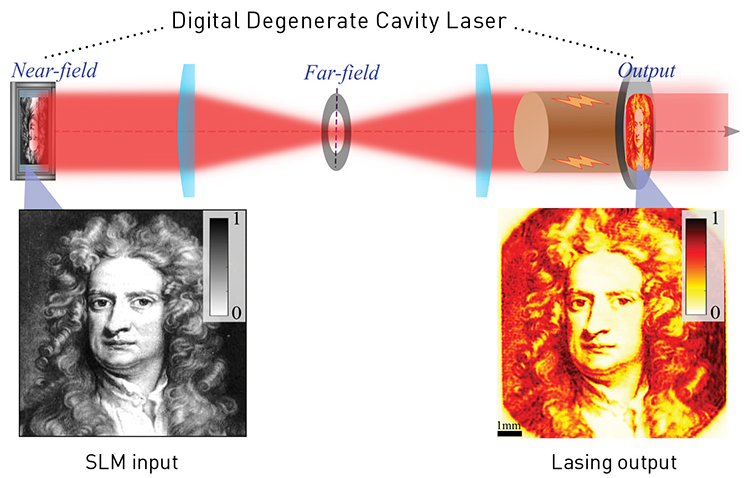 A digital degenerate cavity laser arrangement allowed the generation of a Newton lasing mode in less than 1 μs. A laser output beam with a desired distribution is obtained by controlling the intensity, phase, and coherence distributions inside the laser cavity using a near-field digital SLM and an adjustable far-field aperture. [Newton portrait: © National Portrait Gallery, London]
A digital degenerate cavity laser arrangement allowed the generation of a Newton lasing mode in less than 1 μs. A laser output beam with a desired distribution is obtained by controlling the intensity, phase, and coherence distributions inside the laser cavity using a near-field digital SLM and an adjustable far-field aperture. [Newton portrait: © National Portrait Gallery, London]
High-resolution, arbitrarily shaped laser beams with high brightness and tunable spatial coherence, useful for basic research and a variety of applications, have captured much recent attention. In work over the past year, we have devised a novel and efficient method to create such laser sources, and used the method to generate a variety of complex, digitally controllable beams.
Generally, a laser beam can be shaped by controlling intensity, phase and coherence either directly at the source or externally. In beam-shaping approaches external to the laser source, the beam’s intensity, phase or coherence are controlled separately. Such controls are relatively slow and cannot yield high-resolution, arbitrarily shaped beams. Moreover, the coherence control suffers from high power loss, and is not practical—if it is feasible at all.
Beam shaping at the laser source is commonly performed by dynamically controlling the intensity and phase distributions in a conventional laser using an intra-cavity spatial light modulator (SLM), to digitally select and control specific modes.1 Unfortunately, the number of lasing modes in such a laser is modest, yielding only low spatial resolution. Further, these schemes provide only limited control of the laser light coherence, needed for applications such as the generation of propagation-invariant and speckle-free laser beams.
By resorting to a degenerate cavity laser that incorporates an intra-cavity digital SLM and an intra-cavity spatial Fourier filter, it is possible to exploit a very large number (about 105) of independent lasing modes with direct access to both the near-field and far-field planes—providing full, independent control of all of the beam’s degrees of freedom.2 We have used this approach to develop a novel, rapid and efficient method to generate high-resolution laser beams with arbitrary intensity, phase and coherence distributions.
To show the efficacy of our method, we generated a variety of unique and high-resolution complex laser beams for which the spatial coherence can be rapidly tuned, with a little change in the laser output power.2 Further, by simultaneous control of intensity, phase and coherence, we showed that a shaped laser beam can be efficiently reshaped after free-space propagation into a completely different shape—and that extremely high-order laser modes can be generated with high fidelity.
As other recent work has shown, high-resolution digital control in degenerate cavity lasers, such as those we have demonstrated, can also be exploited for demonstrating first-order phase transitions in crowd sychrony,3 simulating spin systems,4 and laser solvers for optimization and other hard mathematical problems.5
Researchers
Chene Tradonsky, Simon Mahler, Asher A. Friesem and Nir Davidson, Weizmann Institute of Science, Rehovot, Israel
Vishwa Pal, Indian Institute of Technology Ropar, Rupnagar, Punjab, India
References
1. S. Ngcobo et al. Nat. Commun. 4, 2289 (2013).
2. C. Tradonsky et al. Optica 8, 880 (2021).
3. S. Mahler et al. Phys. Rev. Res. 2, 043220 (2020).
4. V. Pal et al. Phys. Rev. Res. 2, 033008 (2020).
5. I. Gershenzon et al. Nanophotonics 9, 4117 (2020).
